Case Report: 21CA001
A 16-year-old tire repair assistant died when a vehicle slipped off a hydraulic jack and fell on him while he was changing the oil
Download a PDF to print this report:
Introduction
On Wednesday, May 12, 2021, at approximately 5:45 p.m., a Hispanic 16-year-old male repair assistant working in a tire shop died when the vehicle he was working under fell off a hydraulic jack and crushed him. The CA/FACE investigator received notification of this incident on May 20, 2021, from the Cal/OSHA Weekly Fatality Report. On May 28, 2021, contact was made with the employer of the victim. On June 2, 2021, the CA/FACE investigator traveled to the scene of the incident and interviewed the employer of the victim. Attempts to interview the co-workers were unsuccessful. The CA/FACE investigator also visited the high school the victim attended and interviewed the auto shop teacher who had the victim in his class two years prior to the incident, during his freshman year of high school. The county coroner, fire department, and sheriff’s department reports of the incident were also obtained and reviewed.
Employer
The employer of the victim was a small tire shop with two bays that was established in 2005. There were no vehicle hydraulic lifts or service pits that could be used to change oil. The shop was designed to sell and install tires and service automobiles, heavy duty trucks, and farm equipment. There were only three full-time employees – the owner, the owner's brother, and the owner's father. There were also two part-time employees – the victim and another teen (both 16 years old) who worked in the tire shop after school.
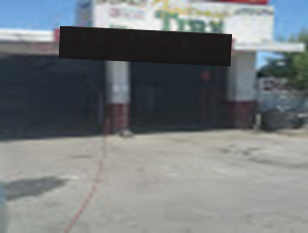
Exhibit #1. The tire shop exterior where
the incident occurred.
|
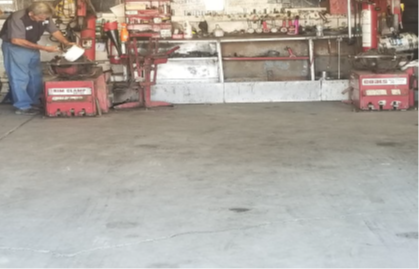
Exhibit #2. The tire shop bay where
the incident occurred.
|
Written Safety Programs and Training
The employer did not have a written safety program. When the teenagers started working in the tire shop they were given verbal instructions on how to do certain tasks and were told to always place a jack stand under raised vehicles when working on them. The tire shop owner knew that the victim had taken an auto shop course in high school but was not aware what skills were taught.
Worker Information
The victim was a junior at the local high school and was a member of the Future Farmers of America (FFA) at his school as well as being on the varsity soccer team. He took an auto class two years prior during his freshman year that focused on small engines such as lawnmowers and garden power tools. Previously, he had been working at the tire shop part-time during the summers for approximately two years. In the year prior to the incident he began working after school two to three days a week. The other teen had just started working part-time after school and had not taken any auto shop classes in high school. According to the high school they attended, neither student had requested a work permit application to work at this tire shop.
Investigation
At the time of the incident, COVID-19 restrictions were starting to be lifted and students were returning to in-person classes and after-school jobs. On the day of the incident, the victim and his teenage co-worker arrived at the tire shop after school. The only other employee working was the owner’s father. It was a slow day but the normal tasks of cleaning the work bays, tools, and equipment kept them busy.
At approximately 5:30 p.m. (30 minutes before closing), a customer came in with a flat tire and the two teens agreed to change it. The vehicle was guided into the service bay and a hydraulic jack (Exhibits 3 & 4) was placed underneath the vehicle behind the left front tire.
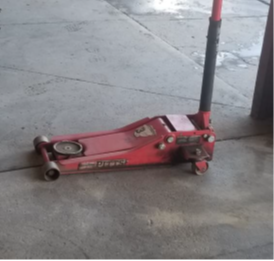
|
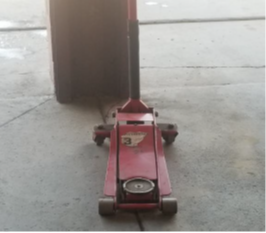
|
Exhibits #3 & 4. Different views of one of the two hydraulic jacks used in the incident.
The vehicle was raised up to a height just high enough to remove the flat tire. While the vehicle was being serviced, the customer also requested an oil change. The victim placed a second hydraulic jack behind the right front tire of the vehicle and raised it off the floor. The front of the vehicle was now suspended by two hydraulic jacks. The victim then crawled underneath the vehicle to access the engine’s oil pan drain plug. The owner’s father went to the back of the shop to find a pan to contain the used oil that would be drained from the vehicle. The teen co-worker was standing in front of the raised vehicle and the vehicle owner was standing outside the shop bay. Suddenly, the hydraulic jack on the left side of the vehicle shifted, and the raised vehicle fell on the victim. The teen co-worker, using the same jack, raised the vehicle up and pulled the victim out from under the vehicle by his legs and helped him stand up for a very short time before he collapsed onto the shop floor. The vehicle owner immediately called 911. The first arriving firefighter lived approximately three blocks from the incident scene and arrived quickly. He observed the victim lying face down on the concrete floor vehicle bay, and soon after the victim was pronounced dead.
Cause of Death
The cause of death, according to the death certificate, was blunt force trauma.
Recommendations
The CA/FACE investigator determined that, in order to prevent future incidents, tire shop employers should:
Recommendation #1: Ensure that any employee that is a minor is only doing work in compliance with child labor laws and regulations. For work that is allowed, ensure that minors are properly trained and supervised, and have a work permit.
Discussion: In this incident, the victim and the other teenage co-worker performed tasks that they were most likely familiar with and had done before. However, at the time of his death, the victim was performing a task that, because of his age, was not permitted (Labor Code 1294.5(b)). Sixteen- and 17-year-olds are not permitted to do work using pits, racks, or lifting apparatuses. In addition, neither minor had a work permit, which is required for all students under 18 who are working. Automotive servicing and tire repair can be dangerous work for all ages, and requires detailed training, personal protective equipment (PPE), and attention to safety procedures. At the time of the incident, no one was supervising to ensure that the tasks the teens were performing were being done legally, correctly, and safely. In general, workers under 18-years-old are particularly vulnerable as they do not possess the experience or physical and emotional maturity of adults. Child labor laws do not permit minors less than 18-years-old to work in hazardous environments or perform tasks considered too dangerous for their age. This is based on evidence they are not fully developed neurologically to manage complex situations and have limitations in certain problem-solving abilities. In addition, they may not have developed adequate judgement to determine if an activity/task is hazardous, and may be more likely to engage in high-risk activities.
In this case, the 16-year-old victim took on the task of changing the engine oil and may not have known he was not allowed to perform this work, or the potential hazard of crawling under an elevated vehicle. The victim and the other teen were not currently (or previously) enrolled in an auto mechanic/tire technician apprenticeship program, and the employer had not obtained work permits for either of them. If the employer and/or the victim had been aware that minors under 18 are not permitted to use a lifting apparatus, the victim may not have attempted to change the oil and this fatality could have been prevented. Government agencies, school officials, and health and safety organizations should continue their efforts to inform the public and employers about child labor laws.
Recommendation #2: Ensure that any loads raised by hydraulic jacks are supported with proper cribbing or jack stands.
Discussion: The victim was underneath a raised vehicle that was supported by two hydraulic jacks. Hydraulic jacks are lifting devices, not holding devices (such as jack stands). Hydraulic jacks alone should not be used alone when an employee needs to perform work underneath a vehicle. Cal/OSHA regulations state that employees shall not be permitted to enter the zone beneath a jack-supported load unless it has been effectively blocked or cribbed. If cribbing or jack stands had been used to support the vehicle (see Exhibit 5), the fatal collapse would not likely have occurred.
| 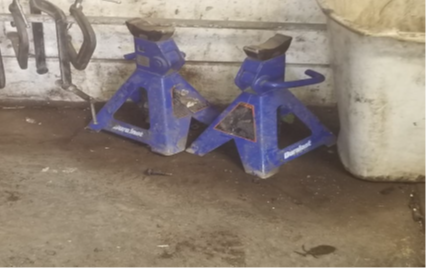
Exhibit #5. The jack stands that were available in the shop but not used on the day of the incident.
|
References
California Division of Occupational Safety and Health - Title 8 regulations - Subchapter 7. General Industry Safety Orders.